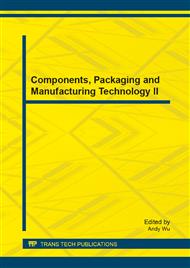p.3
p.9
p.15
p.20
p.27
p.34
p.38
p.44
Preparation and Rheological Characterization of Cross-Linked Dialdehyde Carboxymethyl Cellulose
Abstract:
The carboxymethyl cellulose (CMC) is oxidized to the dialdehyde carboxymethyl cellulose (DACMC) at extremely acid media by sodium periodate. The reaction has been carried out at pH 2.0, temperature 35°C for 1.5h, with a NaIO4/CMC molar ratio of 1.1. FTIR peaks confirm the oxidation of CMC to DACMC. Furthermore, the rheological properties of CMC and DACMC were investigated by using steady shear and dynamic viscoelastic measurement in the range of concentrations (0.5~1 wt%). All of the CMC and DACMC solutions showed a shear thinning behavior over the shear rate at temperature from 30°C to 50°C. The zero shear viscosity (η0) was obtained by using the Cross model to fit experimental data. The η0 values were used for detailed viscosity-concentration and activation energy analysis. The exponent in the viscosity-concentration power law was found to be lower than 1. The activation energy of the DACMC solution was bigger than CMCs. The effect of temperature on the storage modulus (G), the loss modulus (G) were also analyed in this study. In view of the foregoing aspects and our interest in the oxidation of carbohydrates by this oxidant, the present study is of great significant to gain some information on the cross-linked product of periodate oxidation, and is helpful for developing novel carboxymethyl polysaccharide derivatives.
Info:
Periodical:
Pages:
9-14
Citation:
Online since:
February 2014
Authors:
Price:
Сopyright:
© 2014 Trans Tech Publications Ltd. All Rights Reserved
Share:
Citation:


